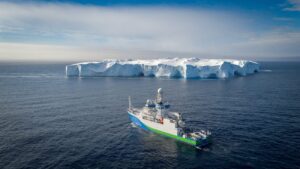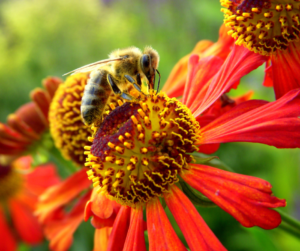Eco-Art or Environmental Art utilises striking installations and sculptures to spotlight environmental concerns. It encourages proactive engagement. These public creations draw attention to the relationship between humanity and the environment.
Christo, Jeanne-Claude, Andy Goldsworthy, Maya Lin, Ned Kahn, and Agnes Denes are prominent eco-artists. Their artworks fuse natural and human-made elements, provoking essential discussions on the planet’s fragility and beauty.
Agnes Denes’ “Sunflower Field,” is a stunning installation made for the Autostrada Biennale. This transformation of a landfill site into a lively sunflower field is a powerful metaphor. The contrast between desolate land and vibrant blooms is a poignant reminder of our impact on the environment. The sunflowers symbolise hope and resilience, showcasing life’s ability to thrive despite challenges.

Likewise, Andy Goldsworthy’s “Stone River” crafts a winding path of stones through a green forest. This artwork integrates with nature and underscores the interconnectedness of all living beings.

Eco-art transcends mere awareness-raising; it sparks actionable change. These artistic interventions can pave the way for a more sustainable future.
Eco Art started in the 1960s and 70s. It was known as the Land Art Movement. Robert Smithson, Michael Heizer, and Nancy Holt were leading figures. They crafted expansive, natural-integrated works in remote areas using rocks, soil, and vegetation. These large-scale creations, were often temporary, subject to nature’s forces.
Environmental Art changed to a more public-engaging form in the 1980s. This transformation brought art into urban areas. , raising awareness of issues like pollution, deforestation, and climate change. The works challenged the community to respond.
Agnes Denes became a pivotal figure during this period. Her piece ‘Wheatfield – A Confrontation’, planted a wheat field on a Manhattan landfill. The installation aimed to highlight the potential of urban spaces for food production.

The Vietnam Veterans Memorial in Washington, D.C. is a famous work created by Maya Lin in 1982. The work was controversial for its starkness and lack of traditional heroism. It has since become one of the most visited and revered war memorials in the world. The wall’s reflective surface creates a powerful visual metaphor. It mirrors the sky, the surrounding trees, and the faces of visitors. It draws the visitors into a contemplative space of remembrance and sorrow. When walking along the wall, the veteran’s names appear to rise from the ground, then disappear. The work symbolizes the loss of life and the passage of time.

Maya Lin continued to produce eco-friendly artworks. The work reflects her commitment to environmental activism. She believes in the power of art to inspire social and environmental change. Lin’s most famous artworks are the three Wave Field renditions: Wave Field (University of Michigan, 1995), Flutter (Miami, Florida, 2005), and Wave Field (Storm King Art Center, 2007-2008).
Modern eco-art utilises landscapes, public spaces, and digital screens. The mission is to sound the alarm on pressing environmental issues and spark action.
Olafur Eliasson’s ‘Ice Watch’ was a chilling commentary on climate change. At the 2014 Climate Change Conference he placed 12 glacial ice blocks in the heart of Paris. It was a stark reminder of a vanishing world, urging action from those with the power to change course.

French artist JR painted his message on a different canvas; Times Square’s towering billboards. His mural featured a young girl defiantly facing a bulldozer. It was a battle cry against deforestation. The sheer scale of the artwork dwarfed the bustling crowds below. It forced viewers to confront the reality of vanishing forests. People had to consider their role in protecting the environment.
Eco-art’s beauty lies in its versatility. Every brushstroke, every towering sculpture, every pixel pulsates with an eco message. Public art urges people to wake up, see the world around them, and take action.
Environmental art has a significant impact on society. It raises awareness about environmental issues and inspires change. Here are more examples of successful environmental art projects:

“The Gates” by Christo and Jeanne-Claude. This public art project featured 7,503 saffron-colored gates in Central Park in New York City. The work aimed to create a sense of joy and beauty in the urban environment. and to encourage people to engage with the natural world.

The Water Tank Project by Mary Jordan. This public art project featured 100 rooftop water tanks in New York City. Artists and students painted the tanks with different designs. The work drew attention to the need for clean water and encouraged people to protect this vital resource.
Environmental art has the potential to continue to inspire change. Artists are using their work to raise awareness about the environmental crisis. Environmental art has the power to engage people. It can help to build a sense of community around environmental issues.
Digital media can create immersive experiences that engage people in new ways. Refik Anadol has created a series of installations that create immersive digital environments. He uses data from natural systems such as the ocean and sky. These works draw attention to the beauty of the natural world. They encourage people to take action to protect it.
Eco-art, a dynamic fusion of creativity and environmental advocacy, has evolved over decades.
Environmental Art has transitioned from remote landscapes to urban settings. It urges contemplation on sustainable agriculture and environmental protection. It compels viewers to recognise their role in protecting the environment.
This art form resonates beyond galleries. It leaves its mark on streets, forests, and digital landscapes.
Environmental Art continues to evolve and inspire change. It uses immersive digital experiences to champion the protection of the natural world. It acts as a powerful advocate for a sustainable future. It encourages dialogue and action in our ongoing relationship with the environment.




